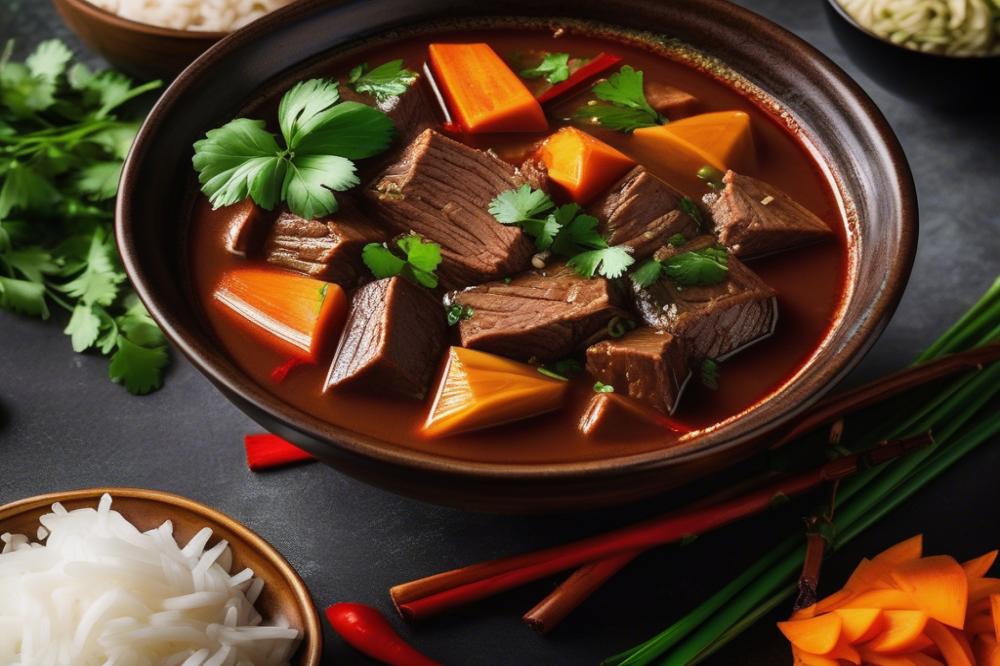Introduction
Vietnamese cuisine is a vibrant and diverse tapestry of flavors. It reflects the country’s history and culture. A balance of sweet, salty, sour, and spicy is cherished in every dish. Street food stalls and local markets brim with colorful ingredients. Fresh herbs and spices play a crucial role in creating vibrant dishes. This variety makes Vietnamese food unique among Asian flavors.
Among the many beloved dishes, beef stew stands out in Vietnamese culture. This comforting meal is more than just food; it signifies family gatherings and shared moments. Bò Kho, a traditional recipe, exemplifies the essence of this warming dish. Each region has its take on it, but the core ingredients remain similar. The stewing process brings out the tenderness in the beef while melding it with aromatic herbs.
The recipe for this beloved dish is not just about cooking meat. It involves braising, which enhances flavor through slow cooking. Key elements like lemongrass and star anise evoke strong aromas. Different families may have their own cooking tips, often passed down through generations. That’s the beauty of Bò Kho; it is deeply personal yet widely appreciated.
When you savor Vietnamese Beef Stew, you experience a piece of its culture. This fusion of warmth and flavor makes it an ideal comfort food choice. As you cook, let the spices guide you to tradition. Engaging with this dish means connecting with a rich culinary heritage.
Vietnamese Beef Stew: A Classic Dish
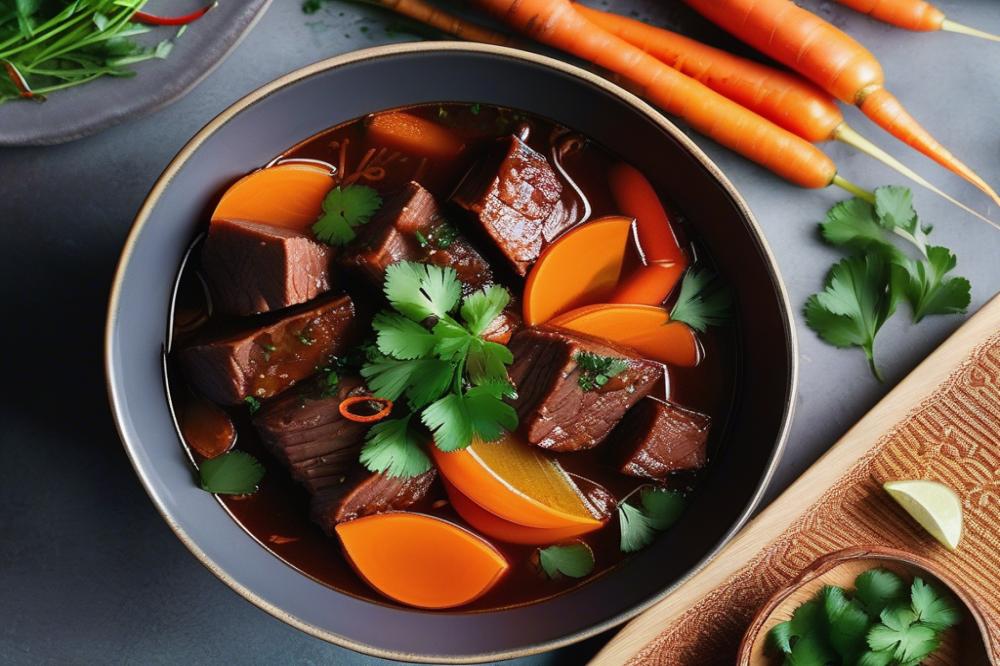

Vietnamese beef stew is a hearty dish deeply rooted in Vietnamese cuisine. This warming dish is made with tender beef, often flavored with a blend of herbs and spices. It is a comforting recipe that is perfect for chilly evenings or family gatherings.
As you dive into a bowl of this beef stew, you can appreciate its rich and savory aroma. Each spoonful warms you from the inside out. People often enjoy it alongside a fresh baguette or rice. The combination of flavors creates a satisfying experience that many love to savor together with friends and loved ones.
The dish draws on a variety of spices that showcase the essence of Asian flavors. Ingredients such as star anise, cinnamon, and lemongrass elevate this classic recipe. Fresh herbs like cilantro or Thai basil add a delightful freshness. This balance of spices and herbs highlights the dish’s complexity and warmth.
Braising is an important technique in preparing this stew. Slow-cooking the beef allows it to absorb all the flavorful elements surrounding it. For an even more delightful dish, consider these cooking tips: choose marbled cuts of beef like chuck or brisket. They will become tender as they cook, making the stew even more enjoyable.
In Vietnamese culture, this beef stew represents more than just a meal; it symbolizes home and togetherness. Enjoying a bowl is reminiscent of family gatherings and shared experiences. It truly embodies the spirit of comfort food.
Ingredients List and Cooking Instructions
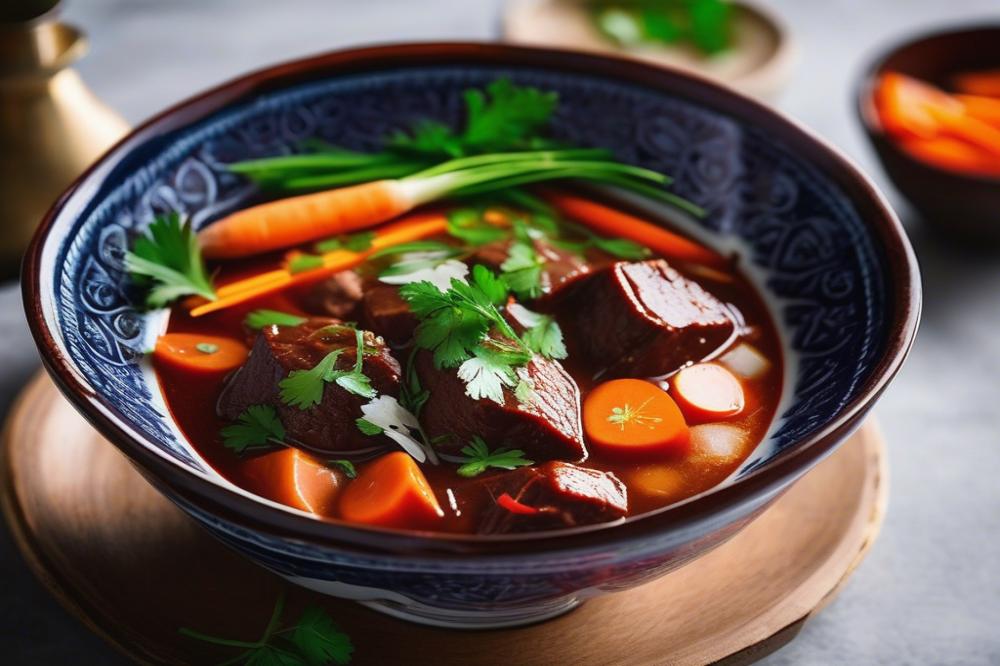

Detailed Ingredients List
- 2 pounds beef chuck, cut into 1 to 2-inch pieces
- 3 medium carrots, sliced into thick rounds
- 2 large onions, chopped
- 4 cloves garlic, minced
- 2 stalks lemongrass, smashed and chopped
- 1-inch piece of ginger, sliced
- 2 star anise pods
- 1 stick of cinnamon
- 4 cups beef broth
- 3 tablespoons fish sauce
- Fresh herbs for garnish: cilantro and basil
Cooking Instructions Step-by-Step
Start by heating a large pot or Dutch oven over medium heat. Add a little oil, then brown the beef pieces on all sides. This step adds flavor.
Next, remove the beef from the pot and set it aside. In the same pot, add the chopped onions and minced garlic. Sauté them until they become soft and fragrant.
Afterward, return the beef to the pot. Add the sliced carrots, lemongrass, ginger, star anise, and cinnamon stick. Stir everything together well.
Pour in the beef broth and fish sauce. This creates a rich base for the stew. Bring the mixture to a gentle boil.
Reduce the heat, cover the pot, and let it simmer. Allow the dish to cook for at least one and a half to two hours. Braising the beef slowly makes it tender.
Check the beef occasionally. If it starts to get too thick, feel free to add more broth or water. Adjust seasoning to taste.
When the beef is fork-tender, remove the pot from heat. Serve the stew hot, garnished with fresh cilantro and basil. This is a comforting dish that showcases true Vietnamese cuisine.
Nutritional Information for Each Ingredient
- Beef: Good source of protein. Contains iron and zinc contributing to energy levels.
- Carrots: Rich in beta-carotene. Great for eyesight and adds sweetness to the dish.
- Onions: Low in calories. Contains antioxidants that are good for heart health.
- Garlic: Provides flavor and may boost the immune system.
- Lemongrass: Adds a fresh citrus flavor. Contains vitamins A and C.
- Ginger: Known for its anti-inflammatory properties. Helps in digestion.
- Spices (star anise, cinnamon): Star anise can help with digestion. Cinnamon may help in regulating blood sugar.
- Beef broth: Provides minerals and collagen, beneficial for skin and joint health.
- Fish sauce: Adds umami elements to the dish. Contains protein but should be used in moderation.
- Fresh herbs (cilantro, basil): Low in calories. Provide vitamins and enhance the flavor profile of the stew.
Braising Techniques for Perfect Bò Kho
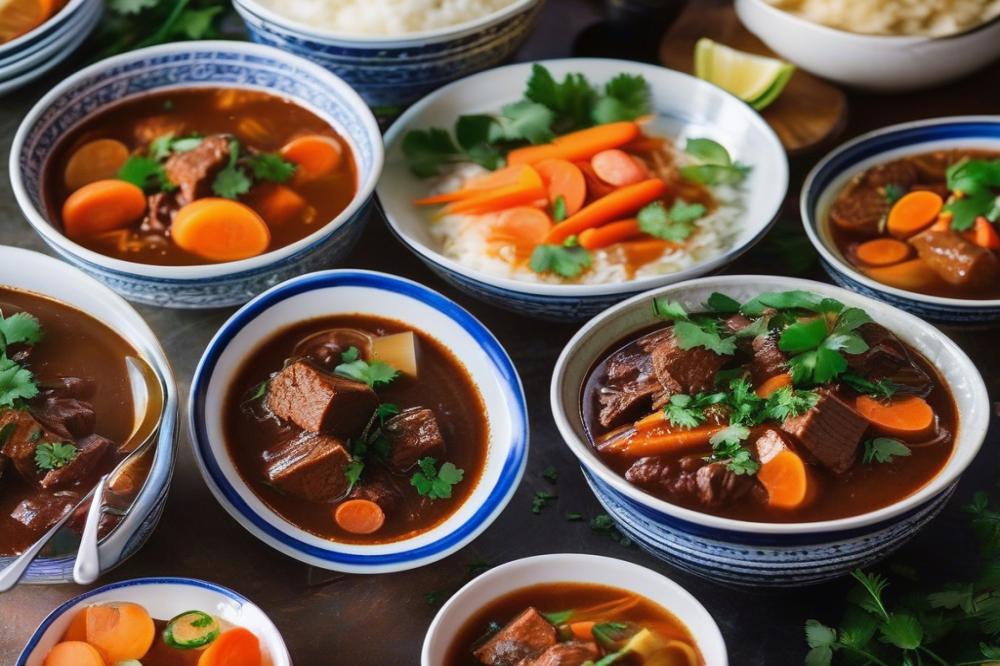

Braising plays a vital role in developing deep flavors in this warming dish. When you slowly cook the beef, it becomes tender and absorbs all the wonderful seasonings. The process transforms simple ingredients into a rich, aromatic stew that embodies the essence of Vietnamese cuisine. As the beef simmers, the herbs and spices meld together, creating an irresistible taste.
Tips for Selecting the Right Beef Cut
Choosing the right cut of meat is crucial for a successful beef stew recipe. Look for cuts that are well-marbled with fat. Chuck roast is a popular choice because it becomes incredibly tender when cooked slowly. Brisket and shank are also excellent options, each adding its own flavor and texture. Freshness matters, so always opt for high-quality beef from a reliable source.
Best Practices for Browning Meat
Browning the meat properly enhances the overall flavor of the stew. Start by heating oil over medium-high heat in a heavy pot. Make sure the pot is hot before adding the beef. This step helps develop a nice crust on the meat that adds depth to the dish. Avoid overcrowding the pot; cook in batches if necessary. When the pieces are browned, don’t forget to scrape any bits stuck to the bottom. Those tiny morsels contribute to the rich taste of the stew.
Keep these cooking tips in mind to create a truly authentic dish. Allow enough time for the beef to braise. Patience is key! After simmering for hours, the collagen in the meat breaks down, resulting in a tender and comforting experience. This traditional recipe invites everyone to gather around the table and enjoy a delightful meal filled with Asian flavors.
Serving Suggestions and Pairings
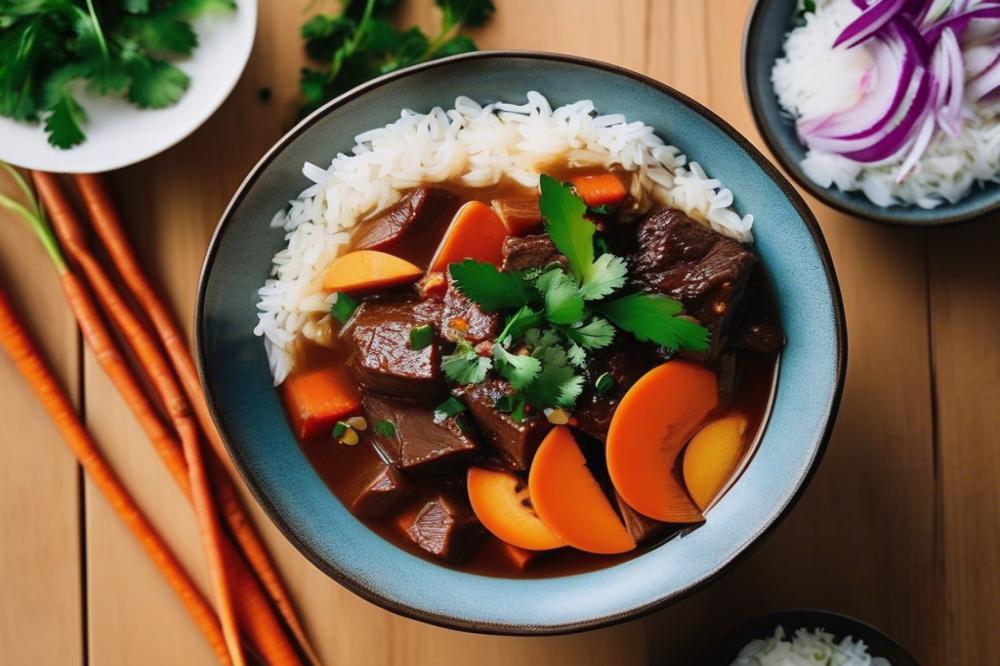

Fans of Vietnamese cuisine often enjoy their bò kho with other delightful accompaniments. A traditional favorite is a crusty French baguette. Dipping this bread into the rich broth enhances the experience. Some people prefer soft, fluffy rice noodles. These noodles soak up the flavors beautifully.
Best Ways to Serve the Stew
Serving the stew in a deep bowl allows you to showcase all the delicious ingredients. A sprinkling of fresh herbs brings vibrant color. Cilantro and green onions work well, adding freshness to each bite. Another popular method is to serve bò kho with rice or rice noodles. This combination makes for a hearty meal, perfect for sharing with family and friends.
Popular Side Dishes and Beverages
Choosing side dishes to complement this comforting dish can elevate the dining experience. Crunchy pickled vegetables add a delightful contrast. They provide a refreshing taste that balances the richness of the beef stew recipe. On the beverage side, iced Vietnamese coffee brings intensity and a touch of sweetness. It pairs nicely with the stew, enhancing the unique flavors of the meal.
Some might also enjoy a light, herbal tea. This offers a soothing effect after the hearty meal. Adding these elements creates a fulfilling dining experience that anyone can appreciate. Feel free to experiment with different herbs and spices to find your ideal combination.
Cooking Tips and Variations
Common Mistakes to Avoid When Making Bò Kho
Using the wrong cut of beef can ruin your dish. Choose tougher cuts like chuck or brisket for better results. Failing to marinate the meat ahead of time can also lead to bland flavors. Add some time for marinating to help the meat absorb those delicious spices. Skipping the browning step will keep your stew from developing rich flavors. Don’t rush this part; take your time to achieve that deep color. Overcooking the vegetables can lead to mushiness. Maintain a balance; veggies should be tender yet slightly firm.
Variations in the Recipe Based on Regional Preferences
Vietnamese cuisine varies from region to region. In southern Vietnam, you might find the dish sweeter, with added coconut milk or sugar. Meanwhile, in the north, the emphasis is on the savory broth and a more pronounced spice level. Some people even include lemongrass or star anise to enhance the flavor. These ingredients add a distinct twist to the traditional recipe. Be open-minded and explore different regional styles when cooking your stew. Some may prefer to serve it alongside rice noodles instead of bread.
Ideas for Customizing the Flavors with Different Herbs and Spices
Changing up the herbs and spices can transform this warming dish. Consider adding Thai basil or cilantro for a fresh taste. These can infuse your stew with vibrant Asian flavors. For a bit of heat, try incorporating sliced chili peppers or a dash of chili powder. Cardamom or cloves can add an interesting depth to the aroma. Experimenting with lemongrass gives a citrusy twist that many love. You might want to adjust the seasoning to suit your palate. The beauty of this beef stew recipe lies in its versatility; make it your own!
Final Thoughts on Vietnamese Beef Stew
Vietnamese beef stew is more than just a dish; it’s a cherished part of the culture. This stew brings together rich flavors and comforting aromas, making it a favorite for many families. Often enjoyed during gatherings, it serves as a reminder of tradition and togetherness. This hearty meal is particularly special during colder months when people crave warmth and nourishment.
Trying this beef stew recipe at home is an exciting adventure. Gathering fresh ingredients and simmering them together can be both rewarding and enjoyable. Each step offers a chance to connect with the essence of Vietnamese cuisine. You might find joy in sharing this meal with friends or family, creating new memories that will last a lifetime.
Don’t hesitate to explore this dish yourself. It’s an invitation to discover different flavors and techniques that define Vietnamese cooking. Understanding and preparing traditional meals like this one fosters a deeper appreciation for diverse culinary practices. In the end, this stew is not just about eating; it’s about celebrating culture and the love of good food.

